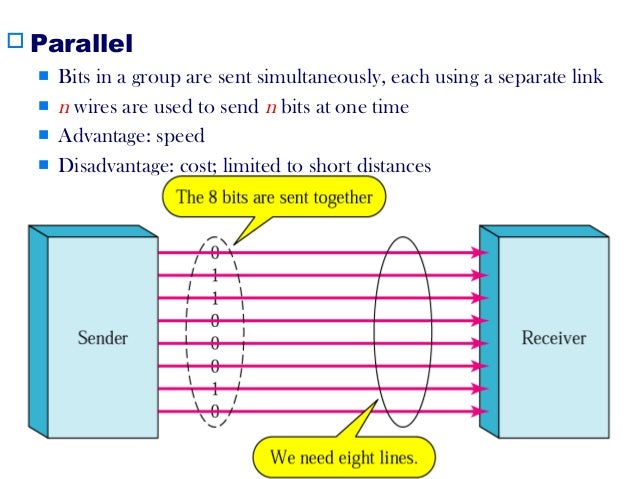Advantages And Disadvantages Of Serial And Parallel Data Transmission

Apr 12, 2016 - One of the major differences is that; in Serial Transmission data is sent. And Parallel Transmission have their advantages and disadvantages.
Serial vs Parallel Port Let's consider the advantages and disadvantages of using serial port when compared with parallel port. Serial port has all the advantages of serial data transmission: • The serial port cable can be longer than a parralel port cable, as serial port transmits '1' as voltage from -5 to -12V and '0' as voltage from +5 to +12 V, while parralel port transmits '1' as voltage of 5 volts and '0' as voltage of 0 volts. At the same time the receiver of the serial port receives '1' as voltage from -3 to -25 V and '0' as voltage from +3 to +25 V. Thus serial port can have maximal swing up to 50 volts, while parralel port has maximal swing of 5 volts. Thus the losses in the cable when transmitting data using serial port are less substantial then losses when transmitting data using parralel port.
• The number of wires needed when transmitting data serially is less than when the transmission is parallel. Is the external device has to be installed at a great distance from the computer, the cable with three wires is much cheaper than the cable with 19 or 25 wires if the transmission is parallel.
Still one should remember that there are interface creation expences for every receiver/transmitter. • Further development of serial port is usage of infrared devices which immediately proved popular.
They now include a fi from • Here is your chance to take Zimbra's Troubleshooting training in English! Zimbra network edition crack windows 7.
Many electronic diaries and palmtop computers have inbuilt infrared devices for connection with external devices. • Another proof of serial port universality is microcontrollers. Many of them have inbuilt SCI (Serial Communications Interfaces), used for communication with other devices.
In this case serial interface reduces the number of outputs on the chip. Usually only 2 outputs are used: Transmit Data (TXD) and Receive Data (RXD). Just compare that to minimum of 8 outputs when using 8-bit parralel connection. Surely enough serial port has its drawbacks. The main one is that when organizing serial connection it is always necessary to convert the data into serial code and vice versa. FCoder © 1998 - 2002.
Parallel and serial data transmission are most widely used data transfer techniques. Parallel transfer have been the preferred way for transfer data. But with serial data transmission we can achieve high speed and with some other advantages. In parallel transmission n bits are transfered simultaneously, hence we have to process each bit separately and line up them in an order at the receiver. Hence we have to convert parallel to serial form. This is known as overhead in parallel transmission. Signal skewing is the another problem with parallel data transmission.